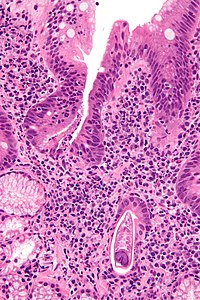
Photo from wikipedia
Co-infections of HIV and other pathogens constitute an important clinical and epidemiological problem. Many studies have played attention to opportunistic co-infections due to the fact that they are used as… Click to show full abstract
Co-infections of HIV and other pathogens constitute an important clinical and epidemiological problem. Many studies have played attention to opportunistic co-infections due to the fact that they are used as an indicator for development of AIDS and are present on the all continents. However, in HIV-infected patients helminth infections, which are not aetiologic agents of opportunistic infections, are becoming more and more important. Prevalence of helminth infection depends on parasite species, environmental and socio-economic factors, therefore the results of published research mainly refer to populations of patients in developing countries and endemic regions. In many cases, pathogenetic mechanisms of these co-infections are not fully recognized, and the obtained results are ambiguous. Thus we performed literature review concerning the course and implications of co-infections with three selected helminth species, of different tissue/organ tropism (Ascaris lumbricoides, Strongyloides stercoralis, Schistosoma sp.), in patients with HIV infection.
Journal Title: Przeglad epidemiologiczny
Year Published: 2018
Link to full text (if available)
Share on Social Media: Sign Up to like & get
recommendations!